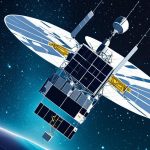Satellite internet access has become a powerful tool in bridging the digital divide and connecting remote areas that previously lacked reliable connectivity. This technological breakthrough has revolutionized the lives of individuals, students, and businesses in these remote regions, enabling them to stay connected and access a wealth of online resources. Through the use of geosynchronous and low Earth orbit (LEO) satellites, satellite internet providers now offer high-speed and low-latency internet access, bringing much-needed connectivity to remote areas.
The Potential of Satellite Internet Access
When it comes to satellite internet access, there are two types of satellites that play a crucial role: geosynchronous satellites and low Earth orbit (LEO) satellites. Each of these satellite systems offers unique advantages and potential for connectivity in remote areas.
Geosynchronous Satellites
Geosynchronous satellites have been the backbone of satellite internet access for many years. These satellites orbit the Earth at a distance of approximately 22,300 miles, remaining fixed relative to a point on Earth’s surface. This stationary positioning allows geosynchronous satellites to maintain a constant connection with ground-based satellite dishes, providing reliable coverage over a specific geographic area.
However, the high distance of geosynchronous satellites from the Earth introduces a notable drawback: high latency. The signals transmitted from the user to the satellite and back to the user have to travel a significant distance, resulting in delays. This latency can affect real-time communications and applications that require immediate data exchange, such as video calls or online gaming.
LEO Satellites
LEO satellites, on the other hand, operate at a much closer distance to the Earth, orbiting at altitudes ranging from 300 to 1,200 miles. This proximity significantly reduces latency, making LEO satellite internet access ideal for real-time communications and interactive applications.
LEO satellite constellations consist of multiple interconnected satellites working together to provide seamless coverage. These constellations enable a continuous network connection, allowing users to stay connected even as they move across different coverage areas.
With low-latency, high-speed internet access offered by LEO satellites, users in remote areas can now fully participate in real-time communications. They can engage in video calls, virtual worlds, and gaming without experiencing significant delays, just like their counterparts in more accessible areas.
The Potential of Real-time Communications
The introduction of LEO satellites has unlocked new possibilities for connectivity in remote areas, especially in terms of real-time communications. This technology bridges the gap between remote communities and the rest of the digital world, enhancing collaboration, social interaction, and access to information and services.
LEO satellites offer low-latency, high-speed internet access, enabling users to participate in real-time communications, including video calls, virtual worlds, and gaming.
One of the key benefits of this improved connectivity is the ability to participate in high-quality video calls. Remote workers, students, and individuals living in remote areas can now connect face-to-face with colleagues, classmates, and loved ones in real-time, regardless of geographical barriers.
Furthermore, LEO satellite internet access brings virtual worlds and online gaming to remote areas. It allows individuals to immerse themselves in virtual reality experiences, join multiplayer games, and engage in real-time online entertainment, just like individuals in urban settings.
The following table provides a comparison between geosynchronous satellites and LEO satellites regarding key connectivity factors:
| Connectivity Factors | Geosynchronous Satellites | LEO Satellites |
|---|---|---|
| Latency | High | Low |
| Speed | Moderate | High |
| Real-time Communications | Limited | Optimal |
As the table demonstrates, LEO satellite internet access surpasses geosynchronous satellites in terms of low-latency and high-speed connectivity, making real-time communications a reality for remote areas.
With the potential of real-time communications unlocked by LEO satellites, remote areas can overcome the limitations of distance and enjoy seamless connectivity with the rest of the world. This has profound implications for various fields, including education, telemedicine, and productivity, empowering individuals and communities in remote locations to thrive in the digital age.
The Affordability Challenge
While satellite internet access has enormous potential for connecting remote areas, affordability remains a significant challenge. Currently, only one satellite internet provider, Starlink, is offering internet service, with other providers like Amazon’s Project Kuiper and OneWeb in the process of launching their own satellite systems. The cost of arranging and launching satellites, securing regulatory approval, and the monthly costs of satellite internet service can be barriers to affordability for many individuals and communities, especially those on limited budgets. Increased competition among satellite internet providers is hoped to drive down costs and make connectivity more affordable for those who need it the most.

Satellite Internet Provider Comparison:
| Provider | Key Features | Availability | Pricing |
|---|---|---|---|
| Starlink | Low-latency, high-speed internet | Global coverage | $99/month |
| Project Kuiper | LEO satellite network | Planned global coverage | N/A |
| OneWeb | LEO satellite network | Planned global coverage | N/A |
| China’s Satellite System | LEO satellite network | China-focused | N/A |
As shown in the comparison table above, Starlink currently offers internet service with global coverage at a monthly cost of $99. However, Project Kuiper, OneWeb, and China’s Satellite System are still in the planning stages and have not disclosed their pricing models. The entry of these new providers into the market is expected to increase competition and potentially drive down costs, making satellite internet access more affordable for remote communities.
Applications of Satellite Internet Access
Satellite internet access has proven to be a game-changer for rural areas, enabling a wide range of applications that have a significant impact on education, healthcare, productivity, and overall connectivity. By bridging the digital divide, satellite internet access is transforming the lives and opportunities of those living in remote communities. Let’s explore some of the key applications:
1. Education:
Satellite internet access brings online educational resources to rural areas, providing students with equal opportunities to access educational materials, participate in remote learning, and complete schoolwork effectively. This ensures that students in remote communities have access to quality education, bridging the educational gap between rural and urban areas.
2. Healthcare:
Through satellite internet access, healthcare services can offer telemedicine consultations and reach patients in far-flung regions. This technology enables remote areas to access medical expertise remotely, improving healthcare outcomes and patient care in underserved areas. It also facilitates the exchange of medical data and patient records, enabling seamless communication between healthcare professionals.
3. Productivity:
Satellite internet access empowers individuals in isolated areas to work remotely and be productive. It provides them with the connectivity necessary to collaborate, communicate, and access online tools and resources. This is particularly important for industries such as agriculture, where farmers can leverage satellite internet technology to optimize their farming practices and access markets and information for better decision-making.
4. Connectivity:
The availability of satellite internet access ensures that rural areas are connected to the digital world. This connectivity not only facilitates communication between individuals, but it also ensures access to vital services, information, and entertainment. Satellite internet access is a lifeline for remote communities, enabling them to stay connected with the rest of the world and overcome geographical barriers.
“Satellite internet access is a transformative technology for rural areas, enabling equal access to education, healthcare, productivity, and overall connectivity.”
In conclusion, satellite internet access brings a multitude of benefits to rural areas. Its applications in education, healthcare, productivity, and connectivity are revolutionizing the way remote communities interact with the world. As satellite internet technology continues to advance and become more accessible, it has the potential to bridge the digital divide and create a more inclusive and connected society.
Conclusion
In conclusion, satellite internet access is revolutionizing connectivity for remote areas and bridging the digital divide. With the advancements in satellite technology, remote communities that were previously isolated are now being connected to the digital world. This has significant implications for education, healthcare, productivity, and overall digital inclusion.
Satellite internet access enables residents in remote communities to access online educational resources, participate in remote learning, and enhance their learning experience. It also facilitates telemedicine consultations, enabling healthcare services to reach patients in far-flung regions. Additionally, satellite internet access empowers individuals in isolated areas to work remotely, collaborate effectively, and access online tools and resources, boosting productivity.
While satellite internet access holds great promise, affordability remains a challenge that needs to be overcome to ensure that connectivity is accessible to all. Currently, limited availability and high costs associated with arranging and launching satellites, securing regulatory approval, and monthly service fees can hinder accessibility for individuals and communities with limited budgets. However, as more satellite internet providers enter the market and competition increases, it is expected that connectivity will become more affordable, further empowering remote communities and fostering a more connected world.
FAQ
What is satellite internet access?
Satellite internet access is a method of connecting to the internet through geosynchronous or low Earth orbit satellites. It allows individuals and communities in remote areas to access high-speed and low-latency internet connectivity.
How does satellite internet access work?
Geosynchronous satellites orbit the Earth at a distance of about 22,300 miles and have been used for satellite internet access for many years. Low Earth orbit (LEO) satellites, on the other hand, orbit at a distance of only 300 to 1,200 miles from Earth, offering low-latency, high-speed internet access. Both types of satellites receive and transmit signals, allowing users to stay connected and access online resources.
Who provides satellite internet access?
Currently, Starlink is the leading provider of satellite internet access. Other providers like Amazon’s Project Kuiper and OneWeb are in the process of launching their own satellite systems. China’s satellite system is also being developed.
Is satellite internet access affordable?
Affordability is a challenge when it comes to satellite internet access. The cost of arranging and launching satellites, securing regulatory approval, and the monthly costs of satellite internet service can be barriers to affordability for many individuals and communities. However, increased competition among satellite internet providers is expected to drive down costs and make connectivity more affordable.
What are the applications of satellite internet access?
Satellite internet access has diverse applications in remote areas. It allows residents to access online educational resources, participate in remote learning, and complete schoolwork effectively. It also enables healthcare services to provide telemedicine consultations and reach patients in far-flung regions. Additionally, satellite internet access supports remote work and productivity for individuals living in isolated areas, ensuring connectivity for collaboration, communication, and access to online tools and resources.




















One Comment